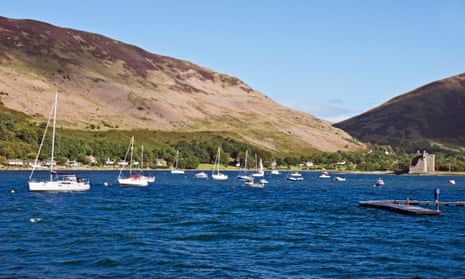Islanders on Arran are protesting against plans to install one of the UK’s largest fish farms close to one of the island’s most treasured holiday destinations.
The Scottish Salmon Company (SSC) wants to build a fish farm near Lochranza on the northern tip of Arran, which will be more than twice the size of most other salmon farms.
The SSC has asked North Ayrshire council for permission to install 20 cages capable of producing 5,000 tonnes of salmon a year, in a 97-hectare (240-acre) site 200 metres off the coastline.
Its opponents argue that the farm will dump faecal waste in the sea equivalent to a town of up to 66,000 people, use acoustic deterrents to ward off seals that will scare porpoises and dolphins, and damage the area’s widely admired landscape.
Residents on Arran staged a human-chain demonstration in the autumn at the site at Millstone Point close to Lochranza, a picturesque coastal village, and are installing six three-metre-long protest banners around the island over the Christmas holidays.
The industry hopes to double its output after the Scottish government announced earlier in 2019 it would allow much larger super-sized farms to be built, but in deeper waters, to remove pressure on sensitive sites close to shore.
Sites of this size are very rare. Only 26 of the 217 fish farms dotted around Scotland’s coastline are licensed to produce 2,500 tonnes of salmon, with a handful where two 2,500 tonnes sites are close together. SSC says its new site at Millstone Point will be split into two licences of 10 cages each, although both groups of cages will be moored together.
Robert Cumming, a former GP who lives in Lochranza and took part in the protests, said villagers were alarmed by the proposal. He fears that Lochranza bay, a popular destination for holidaymakers and sailors, would be heavily polluted by fish farm effluent.
“We just feel it’s being pushed on us for economic reasons, and not for any local benefit,” he said. “It’ll spoil an extremely pretty area, which we want to preserve for future generations.”
The scheme is due to be considered by North Ayrshire councillors early in the new year. The council has received 243 objections, including a formal objection from Scottish Natural Heritage, the government conservation agency.
SNH said the site threatens wild Atlantic salmon spawning in the River Endrick nearby, which is legally protected by a special area of conservation, because it will attract parasitical sea lice. The council needs to carry out a habitats regulations appraisal before voting on the application, SNH added.
Concerns have also been raised by Marine Scotland Science, a government agency, that the site is too close to “disease management area” zones needed for other new fish farm sites nearby, breaching national marine planning rules.
It has told the council it is sceptical that automated equipment SSC wants to use to remove dead fish has been proven to work; the technology has never been used at that scale or in Scottish waters, it said.
SSC, which was recently bought by an aquaculture company from the Faroe Islands, Bakkafrost, from a Ukrainian-financed investment company, argues that the farm will support 10 full-time jobs, buy from local suppliers and put £1m into the local economy.
The company did not allow a director to be interviewed, but said many of the environmental concerns had been answered in its application. “The environment and health of our fish are fundamental and site location is important. Selection is a rigorous process,” a spokesman said.
“[It] has been carefully designed in such a way to ensure that environmental effects have been minimised through the use of innovative technology and enhanced best practice management measures. As such, no significant effects on the natural heritage environment have been identified.”
Paul Chandler, the executive director of Coast, a marine conservation charity on Arran, contested many of the SSC’s figures. Other measurement techniques suggested that the site would produce faecal waste equal to a town of 66,000 people, not one of 14,000 claimed by SSC, while the 10 jobs it cited would involve people living off-island who also worked on other SSC fish farms.
He said Millstone Point was within north Arran’s national scenic area and visible from the north Arran coastal walk, which attracted thousands of tourists every year. This breached the local development plan.
The company had also applied to install 32 acoustic deterrent devices, which send out high-pitched sound waves to scare off seals who try to break into the salmon cages. Chandler said these devices also harm legally protected dolphins and porpoises, species essential to Arran’s eco-tourism industries.
Chandler said there were clear reasons to reject the application. “It’s in a national scenic area, it’s the wrong kind of development in the wrong area. There will be noise impact, visual impact and pollution.”
